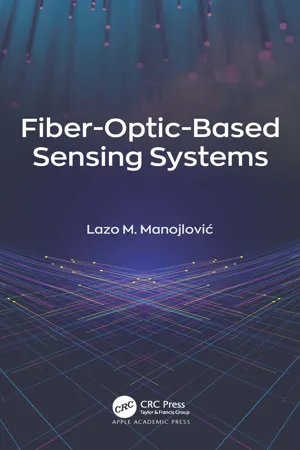
- 328 pages
- English
- ePUB (mobile friendly)
- Available on iOS & Android
Fiber-Optic-Based Sensing Systems
About This Book
The need for both intrinsic and extrinsic fiber-optic sensor technologies continues to grow. To meet the demands of this fast-expanding applications-driven market, this book discusses both the latest advances and recent application opportunities along with the basic optical phenomena, with the main emphasis on applying optical knowledge for solving real-life engineering problems.
Key features of the book:
• Highlights the uniqueness of fiber-optics sensors
• Presents state-of-the-art technology in optical fiber sensors
• Discusses a variety of fiber-optic topologies
• Considers different detection techniques
• Gives special attention to distributed fiber-optic sensing systems
Basic tools and concepts are presented in the earlier chapters, which are then developed in more detail in the later chapters. The book is organized in seven chapters covering a broad range of fiber-optical sensing phenomena. Written for undergraduate and graduate students who want to broaden their knowledge of fiber-optic sensing system applications for real-life engineering problems, the volume is also valuable for engineers who want to acquire the basic principles of optics, especially fiber-optics.
Frequently asked questions
Information
CHAPTER 1 The Properties and the Nature of Light
ABSTRACT
1.1 THE BRIEF HISTORY OF LIGHT PHENOMENA PERCEPTION
Table of contents
- Cover Page
- Half Title Page
- Title Page
- Copyright Page
- Table of Contents
- Synopsis.
- Abbreviations
- Preface
- 1 The Properties and the Nature of Light
- 2 Radiometric and Photometric Measurements
- 3 Optical Detection
- 4 Coherence and Interference of Light
- 5 Fiber Optics
- 6 Low-Coherence Fiber-Optic Sensor Principle of Operation
- 7 Fiber-Optic Sensor Case Studies
- Author Biography
- Index